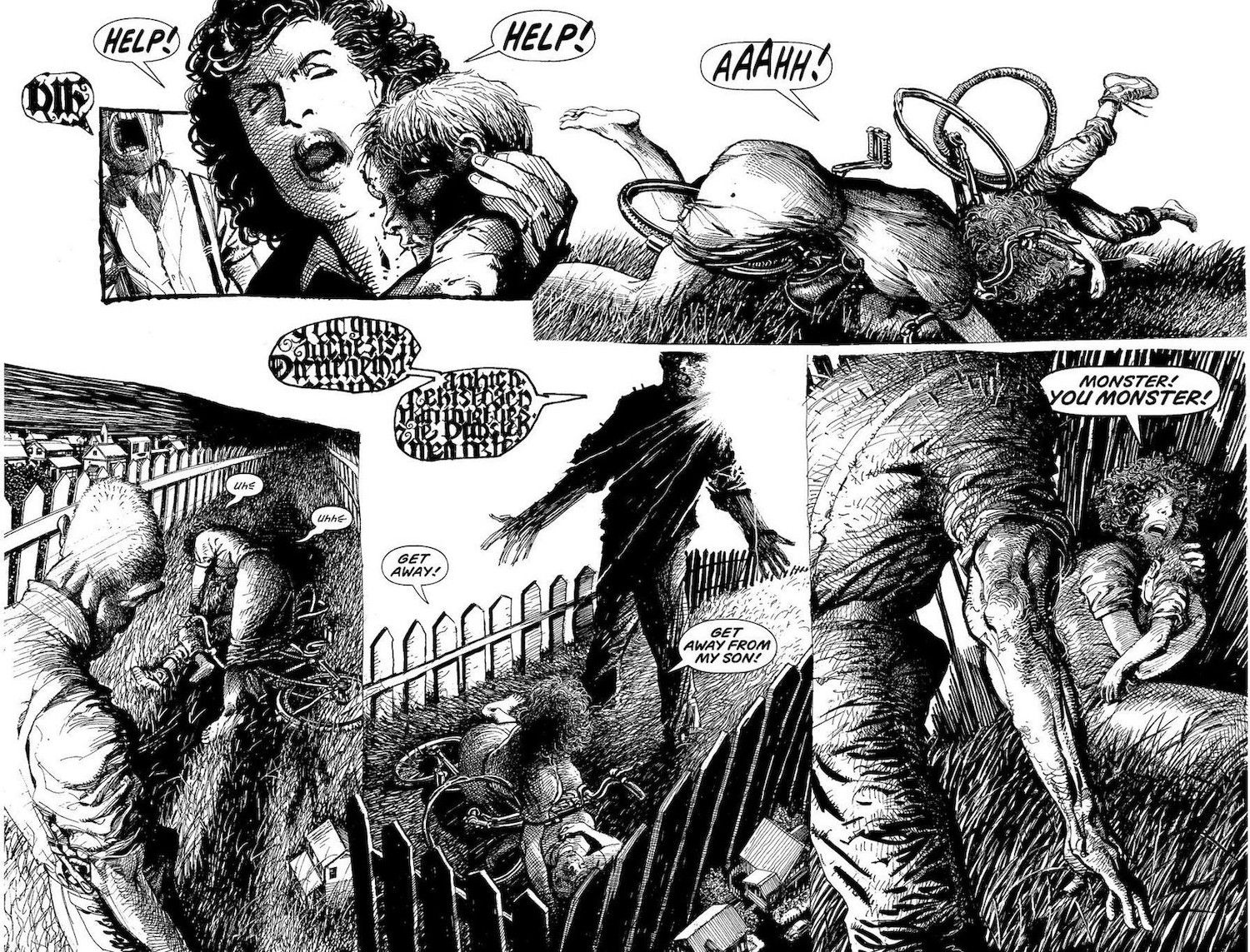 Monsters: doomed and then doomed some more
Monsters: doomed and then doomed some more
Barry Windsor-Smith emerges from many years of silence with a style you recognise in a nanosecond and a book so intensely focused on the despair of the inescapable past and the utter wickedness of mankind that you wonder exactly what those years offstage have involved for him.
If Monsters really is the resurrected starting point of that dusty old Hulk plot-line about Bruce Banner’s abuse as a child, then it also frowns at the eternally tricky concept of using that sort of thing effectively in a Marvel or DC mainstream comic as some mark of artistic maturity in a plot that never ends. The Immortal Hulk comic has lately tied the character’s victimisation into internalised traumas on a chthonic scale, but Smith’s conclusions might be even bleaker: that your fate is imposed from outside not by individuals but by history itself, and you won’t be getting out from under that boulder. Hence this 360 unrelenting pages of adult storytelling which declines to admit a sliver of hope, recovery or cure, embracing instead a bracing Old Testament doom.
The plot that emerges from the book’s flashbacks and multiple narrators circles around the Nazis as the cosmically potent source of death and despair for innocents miles down the timeline. Smith is 71 years old which surely plays a part in this choice of demons, but the story’s weight also pulls back into view the idea that the Third Reich is a low point for Western civilisation on such a scale that it surpasses a lot of raw history and acts as something closer to mystic catastrophe, a cultural devolution, the Un-Enlightenment. One day this idea will drift permanently out of artistic range and dissolve from the cultural ether altogether, a net loss if you ask me; Smith deploys it with such force that you assume he’s been sharing houseroom with it for a long time. Monsters cements that Nazi past into the foundations of American military exceptionalism, and by extension the macho masculine ethos of the country and by further extension the entire violent unknowable cosmos. Then it takes a bearing from American literary establishment, tying together two families in ways that Smith must know are the turf of Stephen King. Beyond the unflinching issues of child unhappiness and pain, rendered viscerally over the 100 pages in which cancer-ridden monster Bobby watches the ghosts of his parents fight and die, Smith really gets his The Shining on when an American GI wanders into a wartime Bavarian Överlöok of Nazi ghosts and is set on a course of destruction for the next several decades. King hovers over the book again later, with a young psychic girl and her dead ghost father, both Shining brightly, shepherding the story’s climax into view via another ghost, this one being the story’s only vaguely good-guy. (These characters are Black, and Smith’s depiction of them is a not entirely happy mix of compassion and manipulation.)
The execution of all this is robust enough to throw fresh light back over Smith’s existing career, which is quite a feat. It certainly indicates no measurable decline in his powers alongside a consistent set of ongoing formal concerns. On some level the work responds to the perfectly valid trend for softer Asian-influenced relativism and renderings of personal identity in comics, since Monsters instead yanks hard on some of the oldest traditions of the Western art canon to deal with cruel absolutes rendered in art that if you squint a bit could look like a woodcut. It’s a breeze block from an old-school source, a deposit from the Bank of America. On top of Monsters’ panel by panel design, which has sights and angles only feasible because of the level of craft and no small imagination, Smith deals in illumination and atmosphere, in light and weather, and Monsters is filled with intense renderings of both those things before we even get to the drawings of skin tones and ethnicities. There are two pages in someone’s living room full of…cigarette smoke, boiling broth?…and the characters are half-glimpsed behind some near-haptic layering of lines and hatchings, art by someone who understands light and ink and putting the two together.
 Monsters: scene one
Monsters: scene one
The final pages seem confounding, since all this pure technique suddenly evaporates to leave a wrack of unfilled outlines and simple open forms, of characters hollowed out. But they balance the first pages 360-odd leaves ago, which are in graphics terms the most thunderously overwrought in the book. An ogre looms in big furious panels, the ground receding at an alarming diagonal with incongruous little houses nestled in the mountainous grass, colossalism run amok, art not yet constrained by the tiers and gutters that enter on page 10. Bobby at the end of the book is an outline, because Bobby’s father at the start is an over-stuffed flexing dervish of wickedness, drawn by Smith to be dissembling on the page, spewing a gothic font with his spasming limbs double- or triple-exposed. To be rid of this ghost is to be emptied of everything.
It’s tough to imagine handing Monsters to someone unfamiliar with comics and inviting them to gaze in wonder at this spell, excelsior. In yet another historical connection, its poignant unforgiving grotesqueness resonated in my head with long-ago incomprehension of old black and white EC comics reprints, whose tone mildly freaked under-10 me out to the point where I didn’t want any more of that thank you. They were serious works dressed in pulpy wrapping; Monsters drills into pulpy sci-fi until it reaches a plutonium core of seriousness. At the very least, old soldier Barry Windsor-Smith has done anything but fade away.